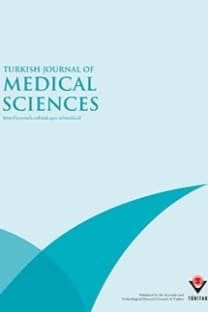Evaluation of organic load-related efficacy changes in antiseptic solutions used in hospitals
Evaluation of organic load-related efficacy changes in antiseptic solutions used in hospitals
___
- 1. Hoang TPN, Ghori MUU, Conway BR. Topical antiseptic formulations for skin and soft tissue infections. Pharmaceutics 2021; 13(4): 558. doi: 10.3390/pharmaceutics13040558
- 2. Mcdonnell G, Russell D. Antiseptics and disinfectants: activity, action, and resistance. Clinical Microbiology Reviews 1999; 12: 147-179. doi: 10.1128/CMR.12.1.147
- 3. Şahiner A, Halat E, Algın Yapar E. Comparison of bactericidal and fungicidal efficacy of commonly used antiseptic formulations according to European standards EN 13727 and EN 13624. Turkish Journal of Medical Sciences 2019; 49: 1564- 1567. doi: 10.3906/sag-1906-53
- 4. Radischat N, Augustin M, Herberger K, Wille A, Goroncy‐ Bermes P. Influence of human wound exudate on the bactericidal efficacy of antiseptic agents in quantitative suspension tests on the basis of European Standards (DIN EN 13727). International wound journal 2020; 17(3): 781-789. doi: 10.1111/iwj.13336
- 5. Chowdhury D, Rahman A, Hu H, Jensen SO, Deva AK et al. Effect of disinfectant formulation and organic soil on the efficacy of oxidizing disinfectants against biofilms. Journal of Hospital Infection 2019; 103(1): 33-41. doi: 10.1016/j. jhin.2018.10.019
- 6. Carling PC, Bartley JM. Evaluating hygienic cleaning in health care settings: what you do not know can harm your patients. American Journal of Infection Control 2010; 38: 41-50. doi: 10.1016/j.ajic.2010.03.004
- 7. Kampf G, Kramer A. Epidemiologic background of hand hygiene and evaluation of the most important agents for scrubs and rubs. Clinical Microbiology Review 2004;17(4): 863-893. doi: 10.1128/CMR.17.4.863-893.2004
- 8. Kim JM, Park ES, Jeong JS, Kim KM, Kim JM et al. Multicenter surveillance study for nosocomial infections in major hospitals in Korea. Nosocomial infection surveillance committee of the Korean Society for Nosocomial Infection Control. American Journal of Infection Control 2000; 28: 454–458. doi: 10.1067/ mic.2000.107592
- 9. Pitten FA, Werner HP, Kramer A. A standardized test to assess the impact of different organic challenges on the antimicrobial activity of antiseptics. Journal of Hospital Infection 2003; 55(2): 108-115. doi: 10.1016/s0195-6701(03)00260-3
- 10. Nicolae Dopcea G, Diguta CF, Matei F, Dopcea I, Nanu AE. Resistance and cross-resistance in Staphylococcus spp. strains following prolonged exposure to different antiseptics. Journal of Global Antimicrobial Resistance 2020; 21: 399–404. doi: 10.1016/j.jgar.2019.10.021
- 11. EN 13727:2015. Chemical disinfectants. Quantitative suspension test for the evaluation of bactericidal activity for instruments used in the medical area. Test method and requirements (phase 2/step 1).
- 12. EN 13624:2013. Chemical disinfectants and antiseptics - Quantitative suspension test for the evaluation of fungicidal activity of chemical disinfectants for instruments used in the medical area - Test method and requirements (phase 2, step 1).
- 13. Chowdhury D, Rahman A, Hu H, Jensen SO, Deva AK et al. Effect of disinfectant formulation and organic soil on the efficacy of oxidizing disinfectants against biofilms. Journal of Hospital Infection 2019; 103(1): 33-41. doi: 10.1016/j. jhin.2018.10.019
- 14. Yoo JH. Review of disinfection and sterilization–back to the basics. Infection& Chemotherapy 2018; 50(2): 101. doi: 10.3947/ic.2018.50.2.101
- 15. McDonnell GE. Antisepsis, Disinfection, and Sterilization: Types, Action, and Resistance; American Society for Microbiology Press: Washington, DC, USA, 2007.
- 16. Cheung HY, Wong MMK, Cheung SH, Liang LY, Lam YW et al. Differential actions of chlorhexidine on the cell wall of Bacillus subtilis and Escherichia coli. Public Library of Science One 2012; 7(5), e36659. doi: 10.1371/journal.pone.0036659
- 17. McDonnell G. General mechanism of action. In: McDonnel GE, eds. Antisepsis, Disinfection, and Sterilization. 2nd ed. Washington DC: American Society for Microbiology Press 2017. pp. 255-269.
- 18. Yoshikawa H, Hirano A, Arakawa T, Shiraki K. Mechanistic insights into protein precipitation by alcohol. International journal of biological macromolecules 2012; 50(3), 865-871. doi: 10.1016/j.ijbiomac.2011.11.005
- 19. Kim M, Weigand MR, Oh S, Hatt JK, Krishnan R et al. Widely used benzalkonium chloride disinfectants can promote antibiotic resistance. Applied Environmental Microbiology 2018; 84: 7–19. doi: 10.1128/AEM.01201-18
- 20. Tong C, Hu H, Chen G, Li Z, Li A et al. Disinfectant resistance in bacteria: mechanisms, spread, and resolution strategies. Environmental Research 2021; 110897. doi: 10.1016/j. envres.2021.110897
- ISSN: 1300-0144
- Yayın Aralığı: 6
- Yayıncı: TÜBİTAK
Ebru GÖK OĞUZ, Kadir Gökhan ATILGAN, Tamer SELEN, Çise KANAR DOĞAN, Serpil Müge DEĞER, Hatice ŞAHİN, Mehmet Deniz AYLI, Fatma AYERDEN EBİNÇ, Gülay ULUSAL OKYAY
Paraoxonase-1 and fetuin-A levels in children with cerebral palsy
Meral YÜKSEL, Özlem GÜNGÖR, Seyda İĞNAK TARLIĞ, Özlem UNAY DEMİREL
Assessment of subclinical cardiovascular alterations in nonfunctioning adrenal incidentalomas
Büşra CAN, Bülent CAN, Pelin KARACA ÖZER, Özge TELCİ ÇAKLILI
Evaluation of organic load-related efficacy changes in antiseptic solutions used in hospitals
Evren ALGIN YAPAR, Bilge Ahsen KARA, Ece HALAT, Aslı ŞAHİNER
Alparslan KILIÇ, Betül CENGİZ ELÇİOĞLU, Saide AYTEKİN, Dilek URAL, Onur BAYDAR, Nihal TEFİK, Füsun HELVACI, Erol GÜRSOY, Yasemin DEMİRCİ, Vedat AYTEKİN
Cumhur GÜNDÜZ, Fethiye Ferda YILMAZ, Can BİÇMEN, Onur KARAMAN, Tülay AKARCA, Şevket DERELİ, Haluk AKIN, Zehra CENGİSİZ, Asude DURMAZ, Hasan TAŞLIDERE, Cengiz ÇAVUŞOĞLU, Mehmet Sezai TAŞBAKAN, Özgür ÇOĞULU, Meltem TAŞBAKAN
Güzide ATALIK, Yusuf Kemal KEMALOĞLU, Metin YILMAZ, Hakan GÖLAÇ
Christos IAVAZZO, Ioannis GKEGKES
Pertussis prevalence among adult patients with acute cough
Serhat ÜNAL, Pınar ZARAKOL, Hatice BÖLEK, Mine Durusu TANRIÖVER, Ahmet İLBAY, Ezgi Çalışkan GÜZELCE
Rumyana STOYANOVA, Desislav TOMOV, Dimitar DELKOV, Lyubka YOANIDU, Ivan DECHEV, Yordanka UZUNOVA
